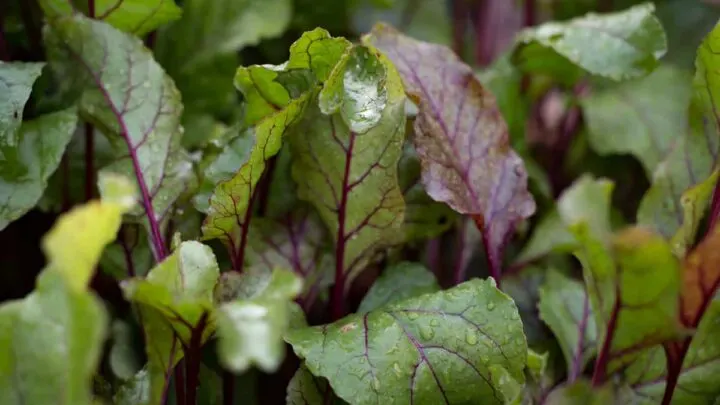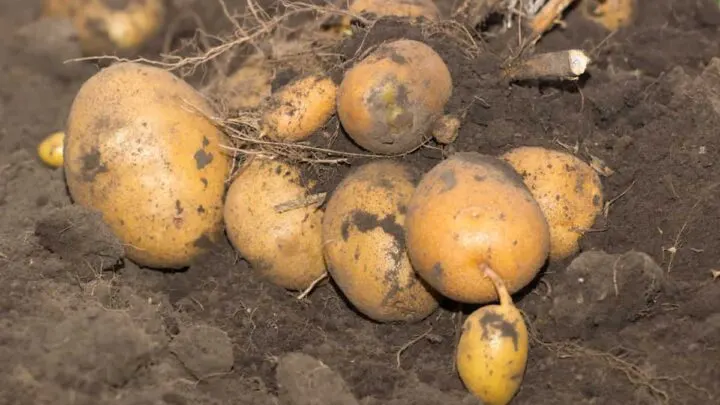Yellow beets are known to be delicious, sweet, and striking to look at. So the last thing you want as a gardener is to watch those bright golden beets turn dark brown or black.
Black usually isn’t a good color on a vegetable. It often means there is a problem, especially on a vegetable that isn’t naturally dark purple or black colored.
Fortunately, blackening beets might be disappointing, but it doesn’t mean something is wrong with them.
Golden or yellow beets turn black because of a form of oxidation after they’ve been cut. It’s normal and can happen relatively quickly. However, beets that are black when you harvest them might have something else wrong with them.
Here’s what you need to know about yellow beets turning black, why it happens, and if that means they’ve gone bad.

Can Beets Turn Black?
Beets can turn black for a couple of reasons. It’s a natural oxidation process that happens when some of the natural proteins in beets are exposed to the air.
Most beets can have this happen, but yellow beets tend to have it happen faster, and it’s also a lot more noticeable because the color change is more drastic.
True black is rare, but dark brown colors are common and may look black in certain lights.
How Do You Tell When Your Beets Have Gone Bad?
Surprisingly, turning black doesn’t necessarily mean that the beet is bad, as long as it was a different color when it was harvested, and the texture is still good.
Beets that are starting to go bad will usually soften. They may shrink slightly and turn wrinkled. Black or brown spots may start spreading from cracks in the beet’s outer skin, but they are a symptom of the beet going bad, not the cause.
Beets may also start to smell different, often more bitter at first and then moldier as they get worse, when they start to go bad.
Checking the texture, firmness, and scent of a beet will usually tell you whether it’s gone bad. Color is less reliable.
What Is The Black Stuff In Beets?
Most of the time black color that develops on beets after they’ve been harvested is simple oxidation. However, if there are black spots on the beet when you harvest it, or you just cut into a beet and notice some black spots inside the beet, where it couldn’t have oxidized, that may be a sign of a more serious problem.
One of the reasons for black stuff in beets is necrotic or dead tissue inside the beet. That can happen when there isn’t enough Boron in the soil, leading to a disorder and necrotizing tissue.
You may want to cut around those spots if you’re eating the beet fresh. They also make it unsafe to can that particular beet.
Other beets from the same area or same plot may have similar problems or may be totally healthy.
It’s a good idea to rotate where you grow your beets at least every three seasons to help prevent disease and ensure the soil is in good condition to produce healthy, black-spot-free beets. Providing adequate fertilizer or compost will also help avoid black spots when harvesting.

Do Peeled Beets Oxidize?
Peeled yellow beets absolutely oxidize, and faster than other kinds of beets. If you want to cook or preserve them, and you also want to preserve their natural golden color, you’ll need to take some precautions to keep them looking bright.
If you want to eat your beets fresh, you’ll need to cut them right before you eat them to preserve the color. But a little oxidization won’t hurt them much. Think of an oxidized beet as something similar than a slightly oxidized apple that’s just turning brown at the edges. It’s a similar process with similar changes in taste and texture.
Why Do Beets Oxidize
Beets oxidize for the same reason other fruits and vegetables oxidize. Some of the components in the vegetable are prone to oxidization, the same process that causes rust on iron, so beets have evolved to have a skin that protects the inner portions of the root from oxygen damage.
When you remove the outer skin or cut into the beet, you expose those vulnerable parts to oxygen, which immediately starts the oxidization process.
How To Protect Cut Or Peeled Beets From Oxidization?
Fortunately, there are some things you can do to help protect your beets from oxidization.
Since yellow beets are particularly prone to this problem, it’s a good idea to put them in water as soon as you’ve peeled or cut them. The water protects them from oxygen exposure but shouldn’t change the flavor or texture of the beets much.
You can drain the water right before cooking if you don’t want a broth, but you can also use the same water for soups and sauces.
For canning, you’ll want to leave the beets in the water until their canning liquid is ready, and then drain them thoroughly in a colander before transferring them to the canning jar and filling them with your canning liquid or brine.
These techniques will help you make the most of your yearly beet harvest!

Should You Wash Your Beets Before Storing Them?
Many gardeners take advantage of easy storage for the hardy root vegetables and gourds from their harvest. These vegetables don’t necessarily need to be preserved or cooked immediately; many are shelf-stable for months after harvest when they’re stored properly.
But, if you put beets in your refrigerator, you would probably wash them. Should you wash the ones you’re putting in your pantry or root cellar for storage?
No!
The main reason you should wash beets is the same reason yellow beets turn black or brown after they’re cut. The beets rely on a thin waxy skin around the outside of the vegetable to prevent oxidization. When you wash the dirt off the beets, you’re likely to damage or completely remove thin skin.
So, instead, gently brush some (but not all) of the excess dirt off each beet, and store them in a bag that allows airflow (fabric bags work best) in a dark, cool, dry place for long-term storage.
Carefully check any beets that have been stored this way for signs of oxidization, softening, or wrinkles on the surface. Minor changes are usually fine as long as the beet still smells okay, but you should use beets that show their age within a week of discovering the problem.
Immediately remove any beets that show signs of molding, are starting to produce liquid from cracks in the skin, or have heavy wrinkling and other signs of damage. Removing these beets promptly will help keep the rest of your beets healthy and delicious!

Hi there, my name is Allie and welcome to my blog; GareningWithAllie!
Much of what you see written here is just our personal experiences with gardening. Along with the content I write here, there is also a unique collection of gardening topics covered by some of our close friends. I hope you find everything you read here to be helpful, informative, and something that can make your gardening journey the most lovely experience ever! With that said, Happy Gardening!
